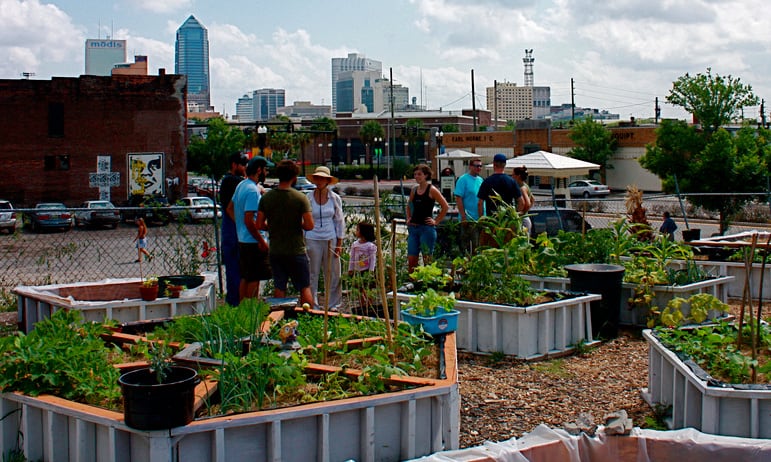An Unbiased View of City Blooming
An Unbiased View of City Blooming
Blog Article
Getting My City Blooming To Work
Table of ContentsCity Blooming - The FactsAll about City BloomingWhat Does City Blooming Do?Some Of City BloomingSome Known Details About City Blooming
Intrigued in growing food available in the City of Chicago? Considering starting a community garden? Adjustments to the Chicago Zoning Ordinance allow farming usages like neighborhood gardens and city farms in several parts of the city. Below is a checklist of regularly asked inquiries concerning the guidelines and laws that growers need to think about when preparing an urban agriculture task.
The zoning change does not change any type of other codes managing composting, structure authorizations, acquiring or renting City possessed residential or commercial property, organization licenses or environmental contamination. There are existing codes that regulate these problems and they continue to be completely impact and may be suitable to your task. Neighborhood yards are usually possessed or managed by public entities, civic companies or community-based organizations and kept by volunteers.
Urban ranches grow food that is meant to be sold, either on a nonprofit or for-profit basis. Due to their industrial purpose, city ranches need a company certificate.
Excitement About City Blooming
The amount of garden compost product can not exceed 25 cubic backyards at any kind of offered time according to the requirements in 7-28-715 of the City's Municipal Code. Due to the fact that the dirt at the majority of brand-new yard websites requires amending, compost, soil, timber chips, or various other materials can be obtained to build or improve the growing area.

If a structure license is needed then the hoophouse will certainly be considered an accessory building. You can learn more about the structure license needs by getting in touch with the Department of Structures. The 25,000-square-foot dimension restriction is meant to avoid a solitary area garden from controling a given block or taking away from the block's existing household or commercial character.
The limitation does not use to yards situated in Public Open Space (POS) districts. Can there be more than one area garden that is 25,000 square feet on a single block? Secure fencing is not needed, nevertheless, yards that have large parking locations may be needed to install secure fencing or various other landscape design functions.
Things about City Blooming
B1 & B2 areas require that all commercial usage activities be carried out inside. R areas restrict business activity. The regulations show the function and intent of the Zoning Code. Is secure fencing required for urban ranches? Yes. Fencings might be required, in addition to landscape design and screening, for sure parking lot and exterior work or storage space locations depending upon location and the details activity happening.
Urban farms require structure licenses and zoning authorizations prior to building (indoor plants). Various other forms of city review may be called for depending on specific frameworks, tasks, dimension, landscape design, licensing, public heath and stormwater monitoring concerns.
Yes. The kind of permit is determined by what is occurring at the website. The Division of Business Matters and Consumer Defense can aid determine the certain type of business license that's called for. Yes. Off street car parking is required for a lot of commercial projects in Chicago. The required variety of garage is based upon the variety of staff members functioning on site and not the square video of the expanding space.
Fascination About City Blooming

A metropolitan farm can sell compost product generated on site, nonetheless, the procedure must abide with the regulations in 7-28-715 of the Chicago Municipal Code. Aquaponic systems are allowed indoors on city ranches in several zoning areas.
Up to five hives or swarms of honey bees might be kept as an accessory use. However, beekeepers should register with the Illinois Division of Agriculture. For more details regarding the suggested zoning amendment you might contact the Department of Real Estate and Economic Development, Bureau of Preparation and Zoning at 312.744.8563.
Farming in cities and urban areas A city farm in Chicago. Urban farming describes numerous practices of growing. https://yoomark.com/content/home-city-blooming, processing, and dispersing food in city areas. The term also puts on the location tasks of pet husbandry, aquaculture, beekeeping, and gardening in an urban context. Urban farming is differentiated from learn the facts here now peri-urban agriculture, which occurs in country areas at the edge of residential areas.
The Main Principles Of City Blooming
It can include a movement of organic cultivators, "foodies" and "locavores", that look for to create socials media based on a shared values of nature and community holism. These networks can establish using formal institutional assistance, coming to be integrated into neighborhood town preparation as a "change town" movement for sustainable metropolitan development.
Some of the first proof of urban agriculture comes from Mesopotamia.
Report this page